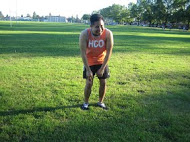Shin splints is pain felt along the shin bone which is the large bone found in the front of the lower leg. Shin splints are quite common among dancers, runners and those under military training. The muscles, tissues of bones and tendons are overworked due to increased activity.
[youtube url=”https://www.youtube.com/watch?v=Sg3WjVce4Zk” width=”220″]Symptoms
- Tenderness, soreness or pain can be felt along the inner part of the lower leg
- Mild swelling of the lower leg
- Pain that happens during exercise
- A dull ache felt in the front area of the lower leg
- Muscle pain
- Pain in either side of the shin bone
- Numbness and weakness of the feet

Tenderness, soreness or pain can be felt along the inner part of the lower leg
Causes
- Shin splints can be caused by stress reactions to bone fractures. Constant pounding leads to cracks in the bones of the leg and it can be repaired by getting enough rest. If the body does not get enough rest, the small-sized cracks can result to complete fracture or a stress fracture.
- An anatomical abnormality of the foot such as flat foot syndrome.
- Weakness of the muscle in the thighs or buttocks
- Improper techniques while training
- Lack of flexibility
- Running downhill
- Playing sports that requires fast stops and starts
- Running in slanted surface or uneven terrain
- Wearing inappropriate shoes used for running or work outs.
- Flat feet or rigid arches and dancers are susceptible to shin splints.
Treatment of shin splints
- Take plenty of rest and avoid performing activities that causes shin splints. Resting also helps promote fast healing of the condition. Avoid performing sprinting, running or brisk walking while still in pain.
- Perform low-impact exercises such as swimming or biking.
- Apply an ice pack in order to help lessen the inflammation. Wrap a few ice cubes in a towel and apply at 20-minute intervals. Avoid applying ice directly on the skin in order to prevent frostbite.
- Tape shin splints using an elastic bandage or wear a neoprene sleeve for the lower leg to help compress the area and lessen inflammation as well as support the tissues and limited movement of the muscles. Perform gentle movement for the legs in order to help with the proper circulation of blood in the area and eliminates excess fluid from the inflammation.
- Take prescribed non-steroidal anti-inflammatory drugs (NSAIDS) such as ibuprofen, naproxen or aspirin in order to minimize inflammation and pain.
If there still difficulty in getting up and pain in walking, seek medical help immediately.
Tips
- Use an athletic insole in order to help in the softening the blow as the foot lands on hard surfaces or the ground.
- Perform exercises on surfaces such as running track, crushed gravel or grass, run on asphalt roads rather than concrete. Perform aerobic exercises on suspended wooden floors.
- Avoid running up and down hills
- Always warm up before performing any exercises such as gentle stretching and easy walking.
FACT CHECK
https://en.wikipedia.org/wiki/Shin_splints
https://orthoinfo.aaos.org/en/diseases–conditions/shin-splints/
